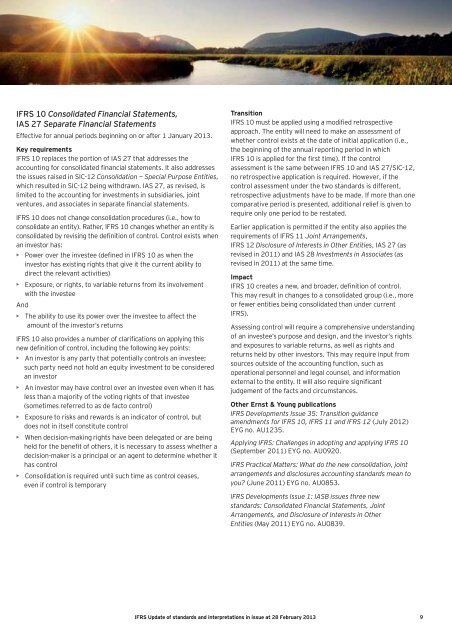IFRS Update
IFRS Update
IFRS Update
You also want an ePaper? Increase the reach of your titles
YUMPU automatically turns print PDFs into web optimized ePapers that Google loves.
<strong>IFRS</strong> 10 Consolidated Financial Statements,<br />
IAS 27 Separate Financial Statements<br />
Effective for annual periods beginning on or after 1 January 2013.<br />
Key requirements<br />
<strong>IFRS</strong> 10 replaces the portion of IAS 27 that addresses the<br />
accounting for consolidated financial statements. It also addresses<br />
the issues raised in SIC-12 Consolidation — Special Purpose Entities,<br />
which resulted in SIC-12 being withdrawn. IAS 27, as revised, is<br />
limited to the accounting for investments in subsidiaries, joint<br />
ventures, and associates in separate financial statements.<br />
<strong>IFRS</strong> 10 does not change consolidation procedures (i.e., how to<br />
consolidate an entity). Rather, <strong>IFRS</strong> 10 changes whether an entity is<br />
consolidated by revising the definition of control. Control exists when<br />
an investor has:<br />
• Power over the investee (defined in <strong>IFRS</strong> 10 as when the<br />
investor has existing rights that give it the current ability to<br />
direct the relevant activities)<br />
• Exposure, or rights, to variable returns from its involvement<br />
with the investee<br />
And<br />
• The ability to use its power over the investee to affect the<br />
amount of the investor’s returns<br />
<strong>IFRS</strong> 10 also provides a number of clarifications on applying this<br />
new definition of control, including the following key points:<br />
• An investor is any party that potentially controls an investee;<br />
such party need not hold an equity investment to be considered<br />
an investor<br />
• An investor may have control over an investee even when it has<br />
less than a majority of the voting rights of that investee<br />
(sometimes referred to as de facto control)<br />
• Exposure to risks and rewards is an indicator of control, but<br />
does not in itself constitute control<br />
• When decision-making rights have been delegated or are being<br />
held for the benefit of others, it is necessary to assess whether a<br />
decision-maker is a principal or an agent to determine whether it<br />
has control<br />
• Consolidation is required until such time as control ceases,<br />
even if control is temporary<br />
Transition<br />
<strong>IFRS</strong> 10 must be applied using a modified retrospective<br />
approach. The entity will need to make an assessment of<br />
whether control exists at the date of initial application (i.e.,<br />
the beginning of the annual reporting period in which<br />
<strong>IFRS</strong> 10 is applied for the first time). If the control<br />
assessment is the same between <strong>IFRS</strong> 10 and IAS 27/SIC-12,<br />
no retrospective application is required. However, if the<br />
control assessment under the two standards is different,<br />
retrospective adjustments have to be made. If more than one<br />
comparative period is presented, additional relief is given to<br />
require only one period to be restated.<br />
Earlier application is permitted if the entity also applies the<br />
requirements of <strong>IFRS</strong> 11 Joint Arrangements,<br />
<strong>IFRS</strong> 12 Disclosure of Interests in Other Entities, IAS 27 (as<br />
revised in 2011) and IAS 28 Investments in Associates (as<br />
revised in 2011) at the same time.<br />
Impact<br />
<strong>IFRS</strong> 10 creates a new, and broader, definition of control.<br />
This may result in changes to a consolidated group (i.e., more<br />
or fewer entities being consolidated than under current<br />
<strong>IFRS</strong>).<br />
Assessing control will require a comprehensive understanding<br />
of an investee’s purpose and design, and the investor’s rights<br />
and exposures to variable returns, as well as rights and<br />
returns held by other investors. This may require input from<br />
sources outside of the accounting function, such as<br />
operational personnel and legal counsel, and information<br />
external to the entity. It will also require significant<br />
judgement of the facts and circumstances.<br />
Other Ernst & Young publications<br />
<strong>IFRS</strong> Developments Issue 35: Transition guidance<br />
amendments for <strong>IFRS</strong> 10, <strong>IFRS</strong> 11 and <strong>IFRS</strong> 12 (July 2012)<br />
EYG no. AU1235.<br />
Applying <strong>IFRS</strong>: Challenges in adopting and applying <strong>IFRS</strong> 10<br />
(September 2011) EYG no. AU0920.<br />
<strong>IFRS</strong> Practical Matters: What do the new consolidation, joint<br />
arrangements and disclosures accounting standards mean to<br />
you? (June 2011) EYG no. AU0853.<br />
<strong>IFRS</strong> Developments Issue 1: IASB issues three new<br />
standards: Consolidated Financial Statements, Joint<br />
Arrangements, and Disclosure of Interests in Other<br />
Entities (May 2011) EYG no. AU0839.<br />
<strong>IFRS</strong> <strong>Update</strong> of standards and interpretations in issue at 28 February 2013 9


